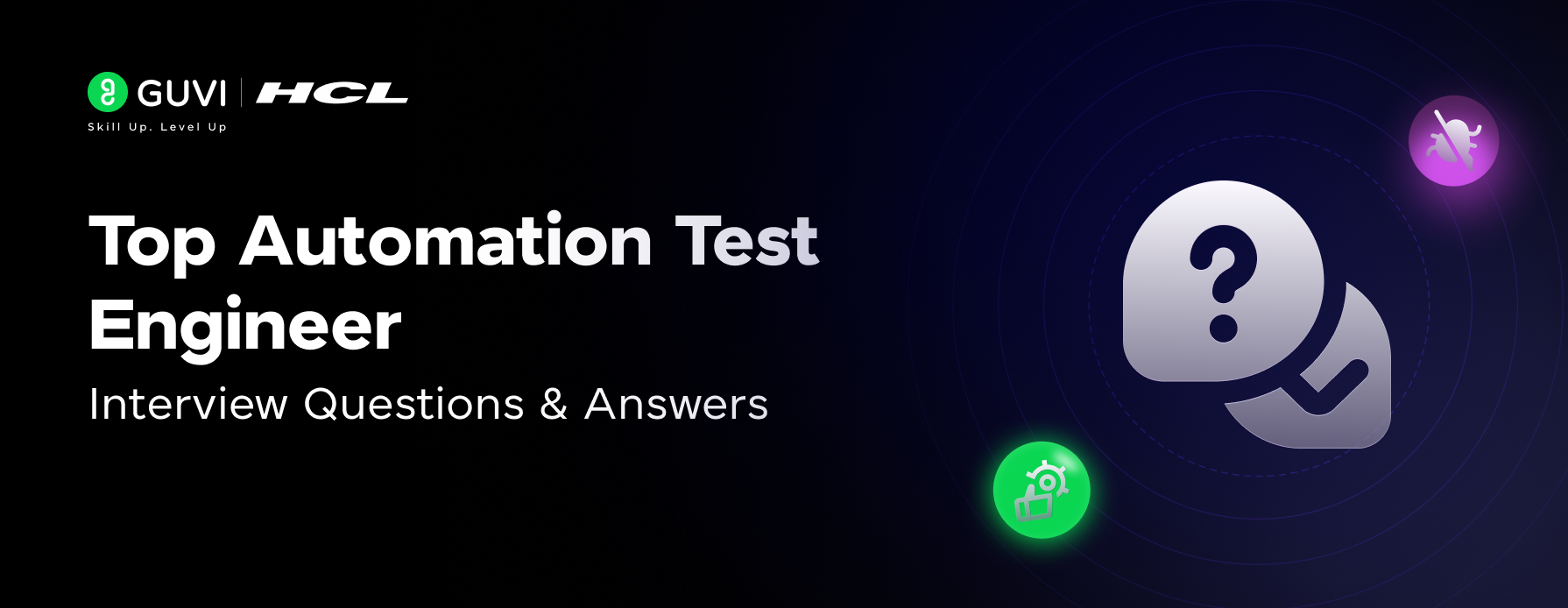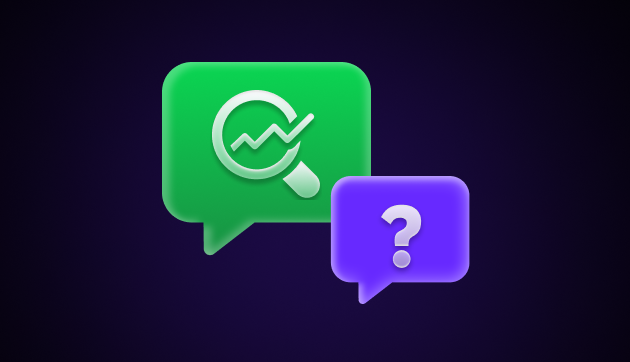
Top 51 Automation Test Engineer Interview Questions and Answers
Mar 29, 2025 12 Min Read 15897 Views
(Last Updated)
Mastering test automation requires a strong understanding of essential skills, tools, and industry best practices. This blog compiles a detailed list of the top 51 automation test engineer interview questions and answers, highlighting key topics such as automation frameworks, programming with Java, managing dynamic elements, and adopting new trends like AI in testing.
With the growing focus on efficient testing in Agile and DevOps, preparing for these automation testing interview questions can substantially boost your chances of success. Understanding the nitty-gritties of various tools, best practices, and real-world scenarios can help you prove your expertise during interviews. It doesn’t matter if you are a newcomer or a thoroughly experienced professional, this guide will build your knowledge to excel and make a strong impression.
Table of contents
- Automation Test Engineer Interview Questions and Answers
- What is Automation Testing, and why is it important?
- What are the key differences between Selenium and QTP?
- Can you explain the different types of test automation frameworks?
- How would you handle flaky tests in your automation suite?
- What are some best practices for writing automation scripts in Java?
- What is the role of Continuous Integration (CI) in automation testing?
- How do you decide which test cases to automate?
- Explain how Artificial Intelligence is being used in test automation.
- What is the difference between smoke testing and regression testing in automation?
- How can test automation be optimized for cross-browser testing?
- What is a Page Object Model (POM), and how does it help in test automation?
- What are some challenges you might face in automation testing, and how do you address them?
- How would you perform mobile automation testing?
- What is TestNG, and how is it used in automation testing?
- How do you ensure your test scripts are maintainable and scalable?
- How can automation testing be integrated into DevOps practices?
- Can you explain how to perform API testing with tools like Postman?
- What is a data-driven testing approach, and when should it be used?
- How do you perform performance testing for web applications?
- How do you implement logging and reporting in your automation framework?
- What is BDD (Behavior-Driven Development), and how does it fit into automation testing?
- How do you perform database testing in automation?
- How do you automate testing for microservices-based applications?
- Explain how Selenium WebDriver handles synchronization issues.
- How would you validate data across different environments in automation testing?
- What is the significance of a test strategy in automation testing?
- What are the benefits of using Git for test automation projects?
- How would you handle test data for automation testing?
- What are some common challenges with automating UI tests, and how can they be mitigated?
- How does Continuous Testing differ from traditional automation testing?
- How do you perform accessibility testing in an automation framework?
- What are soft assertions, and when should you use them in automation testing?
- How do you handle internationalization and localization testing in automation?
- What is parallel testing, and how does it improve test automation?
- How can you perform headless browser testing, and what are its benefits?
- Explain how to automate security testing for web applications.
- What is mutation testing, and how does it apply to automation testing?
- What is the role of Docker in test automation?
- How do you implement logging for API automation tests?
- What is the significance of using a test management tool in automation testing?
- What is the role of AI in test automation, and how can it enhance testing processes?
- How do you implement continuous feedback in automation testing?
- What challenges might you face while automating desktop applications, and how would you overcome them?
- How would you automate testing for a chatbot application?
- Why is it important to incorporate non-functional testing into your automation strategy?
- What are the main components of Selenium WebDriver, and how do they interact?
- How does the Page Object Model (POM) design pattern help with test maintenance?
- What strategies would you use to ensure your automation framework remains robust over time?
- What is end-to-end testing, and how does it differ from system testing?
- How would you measure the success of your automation testing efforts?
- Wrapping up
- Frequently Asked Questions
- Is coding knowledge necessary for automation testing?
- Who can become an automation test engineer?
- What are the most popular industries for automation test engineers?
- Is it possible to automate all test cases?
Automation Test Engineer Interview Questions and Answers
According to a report by Future Market Insights, the global automation testing market is projected to grow at a CAGR of 14.3%, reaching approximately $93.6 billion by 2032. This rapid growth is driven by the increasing adoption of Agile and DevOps practices, along with the integration of AI and cloud-based testing solutions, which help enhance the speed and quality of software delivery across industries like IT, telecom, and finance.
The following section provides a comprehensive list of automation questions that’ll help you hit the right path in your journey to becoming an automation test engineer. Mastering these questions will help you showcase your technical expertise, as well as give you the confidence to tackle complex testing scenarios during interviews.
1. What is Automation Testing, and why is it important?
Answer: Automation testing uses specialized software to execute tests on a software application without manual intervention. It’s important because it speeds up the testing process, enhances accuracy by eliminating human error, and allows for frequent test execution, which improves software quality and reduces time to market. This is particularly beneficial for automation testers working with repetitive test cases.
2. What are the key differences between Selenium and QTP?
Answer: Selenium is an open-source tool used primarily for web application testing, while QTP (Quick Test Professional), now known as Microfocus UFT, is a commercial tool supporting a wide range of platforms, including desktop and mobile applications. Selenium supports multiple programming languages like Java, Python, and C#, whereas QTP mainly uses VBScript. For automation test engineers, the choice often depends on the project’s requirements and budget.
3. Can you explain the different types of test automation frameworks?
Answer: There are several types of test automation frameworks:
- Linear Scripting: Simple scripts recorded and played back.
- Data-Driven Testing: Uses external data to drive test cases.
- Keyword-Driven Testing: Uses keywords defined in a data table to represent actions.
- Modular Testing: Break down the application into small, manageable functions or scripts.
- Hybrid Testing: Combines two or more of the above frameworks to leverage their advantages. Automation test engineers typically choose frameworks based on factors like maintainability, scalability, and ease of integration with other tools.
4. How would you handle flaky tests in your automation suite?
Answer: Flaky tests produce inconsistent results due to timing issues, dependencies on external systems, or poor script design. To address this:
- Add waits or use dynamic waits instead of fixed waits.
- Isolate tests to remove dependencies on other test cases.
- Mock external services where applicable.
- Regularly review and refactor the test scripts to maintain their reliability. Automation testers should proactively identify and fix flaky tests to ensure consistent test results.
5. What are some best practices for writing automation scripts in Java?
Answer: When using Java for automation testing:
- Follow naming conventions and coding standards.
- Use Page Object Model (POM) to separate test scripts from the underlying test logic.
- Incorporate data-driven techniques for tests that require multiple inputs.
- Implement robust error handling with try-catch blocks and logging.
- Maintain test data in separate files for easier maintenance. Automation test engineers using Java should also make use of libraries like TestNG for structured test execution.
6. What is the role of Continuous Integration (CI) in automation testing?
Answer: Continuous Integration is a practice where developers frequently merge their code changes into a shared repository. Automated tests are triggered to validate these changes. The role of CI in automation testing is to catch defects early, ensure code stability, and provide fast feedback to the development team. Tools like Jenkins and Bamboo are popular for integrating CI with test automation processes.
Before we proceed further, it’s essential to have a solid foundation in automation testing principles and selenium basics. If you’re eager to dive deep into software testing, consider joining GUVI’s Selenium Automation Testing Course. In this program, you’ll learn the fundamentals of Selenium, Python, Java, Jenkins, JMeter, API Testing, and more. Gain hands-on experience with industry-standard tools and techniques to get into a professional career focusing on the quality of Product & Process development.
Also, if you want to explore Automation Testing with Python through a self-paced program, try GUVI’s Selenium Automation with Python Course.
7. How do you decide which test cases to automate?
Answer: The decision is based on:
- Frequency of execution: Tests that are repeated often.
- Complexity and risk: Critical functionalities where defects can have severe impacts.
- Data variability: Scenarios with multiple data inputs.
- Feasibility: Tasks that are time-consuming or difficult to perform manually. Automation testers should aim to automate test cases that provide the most return on investment.
8. Explain how Artificial Intelligence is being used in test automation.
Answer: AI is applied to:
- Automate test generation based on code changes.
- Improve visual testing by detecting UI inconsistencies using image comparison algorithms.
- Prioritize test cases based on historical data and risk analysis.
- Automatically identify test objects and adjust to changes in the UI. AI-powered tools are emerging trends that are enhancing the capabilities of automation testers.
9. What is the difference between smoke testing and regression testing in automation?
Answer: Smoke testing is a preliminary test to check whether the basic functionalities of an application work fine after a new build. It’s usually a quick test. Regression testing, on the other hand, involves verifying that recent code changes haven’t negatively impacted existing features. It ensures stability and is often automated to save time.
10. How can test automation be optimized for cross-browser testing?
Answer: To optimize cross-browser testing:
- Use tools like Selenium Grid to run tests in parallel across different browsers.
- Incorporate headless browsers for faster test execution.
- Leverage cloud-based platforms like BrowserStack or Sauce Labs for access to various browser versions and configurations.
- Implement browser-specific locators and configurations in the automation framework. Automation test engineers can achieve consistent results by combining these strategies with robust test scripts.
11. What is a Page Object Model (POM), and how does it help in test automation?
Answer: The Page Object Model is a design pattern in test automation that encourages creating separate classes for each page or component of the application under test. Each class contains methods to interact with elements on that page. POM helps by:
- Improving code readability and maintainability.
- Reducing duplication by centralizing page element locators and actions.
- Facilitating updates: When a page’s layout changes, only the corresponding page class needs to be updated.
This design pattern is especially useful for automation testers working on large applications.
12. What are some challenges you might face in automation testing, and how do you address them?
Answer: Common challenges in automation testing include:
- Handling dynamic elements: These can be addressed using techniques like XPath with contains(), starts-with(), or regular expressions.
- Flaky tests: Regular maintenance and root cause analysis can help fix tests that intermittently fail.
- Cross-browser inconsistencies: Using tools like Selenium Grid or cloud-based services can help test across different browsers and devices.
- Test data management: Storing test data in external files and using data-driven testing approaches helps manage diverse data inputs effectively. For automation test engineers, it’s crucial to adopt strategies that reduce test maintenance and increase script reliability.
13. How would you perform mobile automation testing?
Answer: Mobile automation testing typically involves tools like Appium or Espresso. The steps include:
- Setting up the testing environment with the necessary SDKs and emulators.
- Configuring the automation tool to interact with the mobile device or emulator.
- Writing scripts to automate interactions like swipes, taps, and input.
- Executing tests on real devices or cloud-based services to cover different device configurations. Automation testers often integrate mobile testing with CI/CD pipelines to ensure quick feedback and continuous quality.
14. What is TestNG, and how is it used in automation testing?
Answer: TestNG is a testing framework for Java that supports different testing needs like unit, functional, and integration testing. It allows:
- Grouping and prioritizing test cases.
- Parallel test execution for faster test cycles.
- Generating detailed reports that show passed, failed, or skipped tests.
- Annotation-based configuration for test methods. TestNG is popular among automation test engineers who use Java, as it integrates well with Selenium.
15. How do you ensure your test scripts are maintainable and scalable?
Answer: To keep test scripts maintainable and scalable:
- Use modular and reusable functions.
- Follow coding standards and best practices, such as consistent naming conventions.
- Separate test data from scripts using external data files.
- Regularly refactor and review code to keep it clean and optimized. For automation testers, writing clean code and using frameworks like POM help manage large-scale projects effectively.
16. How can automation testing be integrated into DevOps practices?
Answer: Automation testing is integrated into DevOps by:
- Embedding tests in CI/CD pipelines to run automatically with each code commit.
- Using containerization tools like Docker to ensure consistent test environments.
- Applying continuous testing practices to catch bugs earlier in the development cycle. This approach ensures that automation testers contribute to a culture of continuous quality assurance.
17. Can you explain how to perform API testing with tools like Postman?
Answer: API testing with Postman involves:
- Setting up requests: Define the API endpoint, method (GET, POST, PUT, DELETE), headers, and body parameters.
- Validating responses: Check status codes, response times, and content of the response body.
- Automating tests: Use Postman scripts for assertions or integrate with CI/CD pipelines for continuous testing. For automation test engineers, API testing is crucial to ensure back-end functionality before UI testing.
18. What is a data-driven testing approach, and when should it be used?
Answer: Data-driven testing involves using external data sources (e.g., Excel, CSV, databases) to drive test cases. It’s beneficial when:
- Testing multiple data variations.
- Validating input fields with different sets of data.
- Running the same test with different data values. This approach helps automation testers increase test coverage and reduce script duplication.
19. How do you perform performance testing for web applications?
Answer: Performance testing measures an application’s responsiveness under load. Steps include:
- Setting up performance testing tools like JMeter or LoadRunner.
- Defining test scenarios to simulate different user loads.
- Monitoring system metrics such as CPU usage, memory consumption, and response times.
- Analyzing the results to identify bottlenecks or performance issues. Automation test engineers often combine functional testing with performance testing to ensure comprehensive quality assurance.
20. How do you implement logging and reporting in your automation framework?
Answer: Logging and reporting are implemented by:
- Integrating logging libraries like Log4j in Java to capture detailed logs.
- Creating custom reports using tools like Extent Reports for visual representation of test results.
- Using built-in reporting features of frameworks like TestNG. Effective logging helps automation testers diagnose issues, while reporting provides insights into test coverage and results.
21. What is BDD (Behavior-Driven Development), and how does it fit into automation testing?
Answer: BDD is a software development approach that encourages collaboration between developers, testers, and business stakeholders. It involves writing test cases in a natural language format using tools like Cucumber, which automates those scenarios. In automation testing, BDD helps to:
- Improve communication across teams.
- Ensure tests are understandable by non-technical stakeholders.
- Align tests with business requirements by using Gherkin language (Given, When, Then). This approach is commonly adopted by automation test engineers to enhance collaboration and improve test coverage.
22. How do you perform database testing in automation?
Answer: Database testing involves verifying the backend data’s accuracy and integrity. The steps include:
- Connecting to the database using programming languages like Java or Python.
- Running SQL queries to validate the data against expected results.
- Automating the database interactions with tools like JDBC or database drivers.
- Checking for data consistency after CRUD (Create, Read, Update, Delete) operations. Database testing is crucial for automation testers to ensure the application handles data correctly.
23. How do you automate testing for microservices-based applications?
Answer: Microservices-based applications are tested by:
- Performing API testing for each microservice to ensure individual functionalities.
- Using contract testing to verify the communication between microservices.
- Testing end-to-end workflows involving multiple microservices.
- Implementing service virtualization to mimic dependent services. Tools like Postman, RestAssured, and WireMock help automation testers automate microservices testing efficiently.
24. Explain how Selenium WebDriver handles synchronization issues.
Answer: Synchronization issues occur when the web elements are not immediately available. Selenium WebDriver offers:
- Implicit Waits: Waits for a defined amount of time before throwing an exception if the element is not found.
- Explicit Waits: Waits for specific conditions (like element visibility) before proceeding.
- Fluent Waits: Checks for the element at regular intervals while waiting for a condition. Automation test engineers should use these waits appropriately to handle dynamic elements.
25. How would you validate data across different environments in automation testing?
Answer: Data validation across environments can be done by:
- Running automated test scripts on each environment and comparing the results.
- Using database queries to ensure data consistency across development, staging, and production environments.
- Incorporating configuration files to adapt scripts for different environments. Automation testers should aim for consistency to ensure test results accurately reflect the system’s behavior in each environment.
26. What is the significance of a test strategy in automation testing?
Answer: A test strategy defines the testing approach and serves as a blueprint for automation efforts. It includes:
- Test objectives: What the testing aims to achieve.
- Scope and limitations: What is covered in the automation testing.
- Tools and frameworks: The chosen tools for automation.
- Test data management: How data will be handled during testing. A well-defined test strategy ensures that automation testers can execute tests effectively and consistently.
27. What are the benefits of using Git for test automation projects?
Answer: Git provides several advantages for automation testing:
- Version control: Tracks changes in test scripts and allows rollbacks.
- Collaboration: Enables multiple testers to work on the same project.
- Branching and merging: Facilitates testing of new features without affecting the main codebase. Automation test engineers often integrate Git with CI/CD tools to automate tests and version control together.
28. How would you handle test data for automation testing?
Answer: Handling test data involves:
- Using data-driven testing approaches to run tests with different datasets.
- Storing data in external files like CSV, Excel, or databases.
- Creating synthetic test data when real data is unavailable.
- Masking sensitive information to comply with data protection standards. Proper test data management helps automation testers maintain flexibility and coverage in their test scripts.
29. What are some common challenges with automating UI tests, and how can they be mitigated?
Answer: Common challenges with UI test automation include:
- Frequent changes in the UI: Using a Page Object Model (POM) can help manage locators.
- Flaky tests due to timing issues: Implementing waits and retry mechanisms can help.
- Cross-browser inconsistencies: Leveraging tools like Selenium Grid to test across different browsers. Automation testers should keep their frameworks flexible and scalable to address these challenges.
30. How does Continuous Testing differ from traditional automation testing?
Answer: Continuous Testing involves executing automated tests throughout the development process, not just after code completion. It aims to:
- Provide immediate feedback on code changes.
- Integrate testing into the CI/CD pipeline.
- Enable rapid detection of defects to ensure software quality. Traditional automation testing often occurs at the end of the development cycle, while Continuous Testing is integrated early and runs continuously. For automation test engineers, adopting Continuous Testing practices ensures a shift-left approach to quality.
31. How do you perform accessibility testing in an automation framework?
Answer: Accessibility testing ensures that an application is usable for people with disabilities. It can be automated using tools like Axe, Wave, or Accessibility Insights, which:
- Scan for compliance issues with standards like WCAG (Web Content Accessibility Guidelines).
- Check for common accessibility problems, such as missing alt text, improper heading structure, or insufficient color contrast.
- Integrate into the CI/CD pipeline to catch issues early. Accessibility testing helps automation test engineers maintain inclusive design and compliance with accessibility standards.
32. What are soft assertions, and when should you use them in automation testing?
Answer: Soft assertions allow tests to continue execution even if an assertion fails, while still reporting the failure at the end of the test. This is helpful for:
- Testing multiple conditions within a single test case without stopping the test on the first failure.
- Non-critical validation checks where other parts of the test should still run. Soft assertions are useful for automation testers when verifying multiple independent conditions in a single test.
33. How do you handle internationalization and localization testing in automation?
Answer: Internationalization and localization testing ensure an application functions correctly in different languages and regions. Techniques include:
- Automating tests for different locales using data-driven testing to input various language-specific content.
- Validating date formats, currency symbols, and text alignment for right-to-left languages.
- Ensuring UI elements adapt correctly to translated text. Tools like Selenium WebDriver can be used by automation testers to simulate user interactions across different language settings.
34. What is parallel testing, and how does it improve test automation?
Answer: Parallel testing involves running multiple test cases simultaneously to reduce execution time. It:
- Speeds up test cycles by leveraging parallel execution environments.
- Enables cross-browser testing by testing on different browsers at the same time.
- Integrates well with cloud services like BrowserStack for scaling test executions. For automation test engineers, parallel testing helps optimize resource utilization and accelerate feedback.
35. How can you perform headless browser testing, and what are its benefits?
Answer: Headless browser testing runs tests without a graphical user interface (GUI), using tools like Headless Chrome or PhantomJS. The benefits include:
- Faster test execution as rendering the UI is skipped.
- Less resource-intensive because there is no need to open a browser window.
- Useful for continuous integration environments where quick feedback is essential. Headless testing is ideal for automation testers aiming to speed up their automated test suites.
36. Explain how to automate security testing for web applications.
Answer: Security testing can be automated using tools like OWASP ZAP or Burp Suite, which:
- Scan web applications for vulnerabilities such as SQL injection, cross-site scripting (XSS), or insecure cookies.
- Integrate with CI/CD pipelines to run security tests automatically.
- Generate detailed reports that highlight security issues and suggest fixes. For automation test engineers, automating security testing ensures that vulnerabilities are caught early in the development process.
37. What is mutation testing, and how does it apply to automation testing?
Answer: Mutation testing involves modifying the code slightly (mutating it) to check if the existing test cases can detect the changes. It:
- Assesses the effectiveness of the test suite by ensuring it catches bugs.
- Improves test coverage by identifying gaps where tests may not be robust enough.
- Requires automation tools to generate mutants and run the tests automatically. Automation testers use mutation testing to measure the quality of their test cases and ensure they are not superficial.
38. What is the role of Docker in test automation?
Answer: Docker provides containerization, allowing applications to run in isolated environments. Its role in automation testing includes:
- Consistent test environments by packaging applications with their dependencies.
- Quick setup and teardown of test environments.
- Scalability to run tests in parallel using multiple containers. Automation test engineers use Docker to avoid environment-related issues and enhance test consistency.
39. How do you implement logging for API automation tests?
Answer: Logging for API tests involves:
- Using libraries like Log4j in Java or logging modules in Python to capture request and response details.
- Storing logs for debugging failed tests.
- Customizing log levels to include only relevant information, such as errors or warnings. Proper logging helps automation testers diagnose issues quickly and maintain test transparency.
40. What is the significance of using a test management tool in automation testing?
Answer: Test management tools like TestRail, JIRA, or Zephyr provide:
- Centralized tracking of test cases, test scripts, and execution status.
- Integration with CI/CD pipelines to automatically update test results.
- Traceability by linking test cases to requirements and defects. Test management tools help automation test engineers organize and track testing efforts effectively, ensuring better project visibility.
41. What is the role of AI in test automation, and how can it enhance testing processes?
AI plays a transformative role in test automation by improving the efficiency and accuracy of testing processes. It enables dynamic test generation, where machine learning algorithms analyze the application code and generate test cases automatically based on code changes. AI can also predict which areas of the application are most likely to contain defects, allowing testers to prioritize testing efforts. In visual testing, AI helps by comparing screenshots of the application to detect UI inconsistencies. Additionally, AI-based tools can automate the maintenance of test scripts by identifying changes in the application’s interface and updating locators accordingly. This approach reduces the time and effort spent on manual test case updates, making the automation framework more resilient to changes.
42. How do you implement continuous feedback in automation testing?
Answer: Continuous feedback involves providing ongoing test results to the development team:
- Integrate testing with CI/CD tools: Run tests automatically upon code changes.
- Set up notifications: Use Slack, email, or dashboard alerts for test failures.
- Monitor trends over time: Track metrics such as test pass rates, execution time, and defect density.
- Use dashboards: Display real-time test results for visibility.
- Automate test result analysis: Identify recurring failures and trends.
43. What challenges might you face while automating desktop applications, and how would you overcome them?
Answer: Automating desktop applications can be challenging due to:
- Platform dependencies: The application may behave differently on Windows vs. macOS.
- Limited tool support: Fewer tools exist for desktop apps compared to web or mobile.
- Complex UI interactions: Handling drag-and-drop, right-click menus, or keyboard shortcuts can be tricky.
- Dynamic UI elements: Elements that change frequently or are hidden by default.
- Overcoming these: Use tools like WinAppDriver, SikuliX, or AutoIt to interact with desktop elements. Implement robust locators, handle window focus changes, and write scripts that adapt to platform-specific behavior.
44. How do you handle automation testing for APIs, and what are some challenges you may encounter?
Automation testing for APIs focuses on verifying that the requests and responses between different services are functioning as expected. It typically involves tools like Postman, RestAssured, or JMeter, where tests validate various aspects of the API, such as status codes, response times, and data integrity. Challenges in API testing may include handling different types of authentication, dealing with dynamic data, and managing dependencies on third-party services that may not be under the tester’s control. To mitigate these challenges, it is helpful to implement mocking and service virtualization, which simulate the behavior of external services, allowing tests to run in isolation. Proper logging and detailed reporting can also assist in troubleshooting issues when API tests fail.
45. How would you automate testing for a chatbot application?
To automate a chatbot, the testing approach would involve:
- Simulating user input: Sending various queries to the chatbot and verifying the responses.
- Integrating with NLP services: Automating the validation of different intents and entities.
- Testing conversational flows: Ensuring that the chatbot’s responses follow the expected conversation path, even when the user deviates from the expected input.
Automation tools like Botium or custom scripts using Python can help automation test engineers validate chatbot functionality effectively.
46. Why is it important to incorporate non-functional testing into your automation strategy?
Non-functional testing addresses aspects like performance, security, usability, and scalability, which are crucial for ensuring that the application functions well under various conditions. Automation of non-functional tests can help identify performance bottlenecks through load testing, detect security vulnerabilities by simulating attack scenarios, or assess the application’s usability by validating UI elements across different devices and screen sizes. Incorporating non-functional testing ensures that the application not only meets functional requirements but also performs optimally and remains secure, making it an integral part of a comprehensive automation testing strategy.
47. What are the main components of Selenium WebDriver, and how do they interact?
Answer: Selenium WebDriver consists of several components that work together:
- Driver Classes: These interact with browsers like ChromeDriver, GeckoDriver, etc., allowing WebDriver to automate browser actions.
- Locators: Used to identify elements on a webpage (e.g., ID, XPath, CSS).
- Commands and Methods: Provide capabilities like clicking, sending text, navigating, and waiting for conditions.
Together, these components help automation testers perform end-to-end testing efficiently, supporting complex test scripts.
48. How does the Page Object Model (POM) design pattern help with test maintenance?
POM simplifies test maintenance by separating the test scripts from the code that interacts with web elements. When a webpage’s layout changes, only the corresponding page object needs an update. This centralization makes it easier for automation test engineers to manage locators and actions, thus reducing maintenance overhead.
49. What strategies would you use to ensure your automation framework remains robust over time?
To keep an automation framework robust:
- Regularly update libraries and dependencies to avoid compatibility issues.
- Incorporate modular and reusable functions to adapt easily to changes.
- Use version control systems like Git to track changes and roll back if necessary.
These strategies make sure the framework stays flexible and can handle evolving requirements.
50. What is end-to-end testing, and how does it differ from system testing?
End-to-end testing verifies the application’s complete workflow, from start to finish, including all integrated components (e.g., databases, APIs, third-party services). It focuses on simulating real user scenarios. In contrast, system testing assesses the entire system but may not include external systems or data flows in its scope. End-to-end testing ensures that the whole system works together as expected.
51. How would you measure the success of your automation testing efforts?
Answer: Success in automation testing can be evaluated through:
- Test Coverage: The percentage of functionalities covered by automated tests.
- Defect Detection Rate: Number of bugs caught through automated tests.
- Time Saved: Reduction in testing time compared to manual testing.
- Cost Savings: Lower costs from decreased manual testing efforts.
- Pass/Fail Trends: Monitoring how often tests pass or fail over time.
- Maintenance Effort: The amount of time spent updating scripts versus new test creation.
These metrics help automation testers gauge the impact and efficiency of their automation strategies.
Enroll in GUVI’s Selenium Automation Testing Course. to get your software testing career off to a great start. Here, you can master in-demand skills like Selenium, Python, Java, Jenkins, JMeter, API Testing, and more.
Alternatively, if you want to explore Automation Testing with Python through a Self-paced course, try our Selenium Automation with Python Course.
Wrapping up
We hope that through our comprehensive guide to automation test engineer interview questions and answers you’ve gained the knowledge and insights to prepare for your next interview. Familiarizing yourself with these questions will help you approach the interview with confidence while showcasing the necessary skills in the field.
Use this resource to refine your responses, understand current industry expectations, and stand out as a well-prepared candidate. If you’re new to the field or even have years of experience, mastering these questions will help you succeed and secure a promising career in the domain.
Frequently Asked Questions
While some automation tools have low-code or no-code options, having a basic understanding of coding can be beneficial. It helps automation test engineers write scripts, customize test cases, and handle more complex testing scenarios. However, there are entry-level roles that may require only minimal coding skills.
Anyone with a background in software testing, computer science, or related fields can become an automation test engineer. Even individuals from non-technical backgrounds can transition into this role by learning relevant skills such as programming basics, testing concepts, and automation tools.
Automation test engineers are in high demand across various industries, including IT and software development, finance, healthcare, retail, and telecommunications. Any sector that relies on software applications can benefit from automated testing to improve software quality and accelerate release cycles.
Not all test cases can or should be automated. Understanding the manual testing methods versus automation testing mentors is crucial to the planning and management of all related processes. Tests that require subjective evaluation, have frequently changing requirements, or are performed only once may not be suitable for automation. A balanced approach combining both manual and automated testing is often the most effective strategy.























![Top React Interview Questions and Answers! [Updated] 3 React Interview Questions](https://www.guvi.in/blog/wp-content/uploads/2022/01/Top-React-Interview-Questions-and-Answers.webp)


![Top 20 RPA UiPath Interview Questions and Answers [2025] 5 rpa uipath interview questions](https://www.guvi.in/blog/wp-content/uploads/2023/02/Top-20-RPA-UiPath-Interview-Questions-and-Answers.png)




Did you enjoy this article?